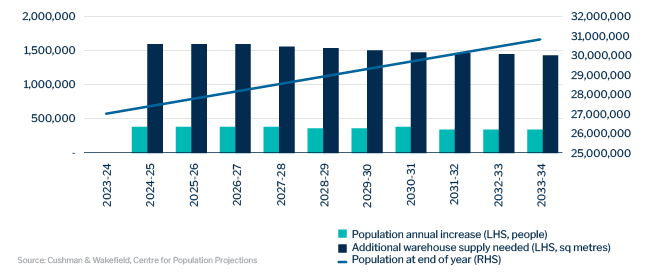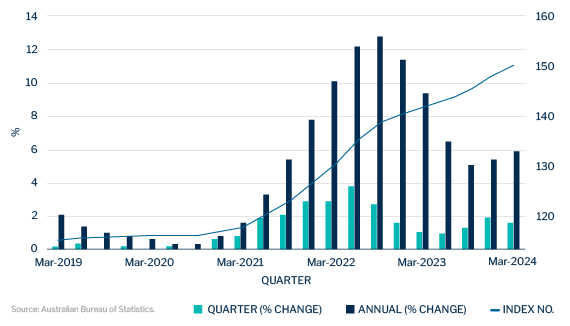The 7 factors that make this part of the property market stand out from the rest
Within asset classes, certain subsectors outperform at different times.
Take equities, for example. We’ve just been through a period of high concentration, led by the Magnificent Seven in the US, and the big banks and miners locally, which have powered indexes to all-time highs. If you weren’t holding the big names, you were left behind.
However, a 'Great Rotation' is occurring in the US, and small and mid-cap stocks are rallying as investors pivot away from the top end.
These intra-asset class shifts are no different when it comes to the property market. While residential grabs most of the headlines, it’s not always the best place to generate a return for investors – or not at all if you’re a Victorian property investor.
So, which part of the property market is investable right now?
To answer that question, I recently sat down with Laurence Parisi, Manager - Trilogy Industrial Property Trust.
The case for industrial
Parisi has been in the property game for 20 years, having worked at Credit Suisse, Citi, Goldman Sachs, Eildon Capital and now Trilogy. It’s safe to say he’s seen all the cycles and knows the space like the back of his hand.
Right now, he’s particularly liking industrial property, noting that after significant growth in Australia, the subsector is now worth close to $300 billion according to CBRE, and expected to surge to $410 billion over the next decade - becoming the biggest sector within the broader commercial property umbrella.
For the uninitiated, industrial property can include warehouses and large buildings used for storage, manufacturing, production, and logistics. Some of the key differences between the way industrial property presents as an investment asset, versus other types of property, lie in the nature of the tenant, lease, and assets in the sector.
Favourable lease terms
One of they features of industrial property is “tenant stickiness”, according to Parisi.
“Industrial property tenants have operations that can be very unique”, says Parisi, adding that they can include “manufacturing, research and development, packaging, handling and storage of products and materials, and the movement of raw materials and product into and out of the facilities”.
The uniqueness doesn’t stop there, however, with the number and types of personnel, suppliers and clientele required to work or conduct business often varying greatly.
And this is to say nothing of the location requirements, which are often very specific for businesses.
All of this specialisation means that once a business finds a suitable location, they are less likely to leave. Anyone who has ever moved house would agree that it’s not a particularly enjoyable experience. Imagine having to move an entire business operation.
As a result, industrial leases tend to be long-term notes Parisi– often 10 years with multiple renewal options – “the benefits of which are reduced downtime and lower costs for investors”.
Favourable rental terms
Industrial rental leases often increase with CPI or are fixed rate, notes Parisi, which gives investors certainty and is an is an advantage compared to leases in other sectors, which are often fixed percentage only.
The advantage that this creates for the industrial sector is that it allows rents to keep pace with inflation in a high-inflation environment, while also protecting downside risk in a low-inflation environment, says Parisi.
Industrial leases are also typically net leases, meaning outgoings and expenses relating to the property are typically covered by tenants.
Strong rental trends
While favourable lease and rental terms are nice, they’re constant and not necessarily why industrial is hot right now.
Rather, industrial’s desirability is being driven by strong rental trends.
According to Parisi, after a long period of subdued rental growth, rents in the industrial sector have been growing strongly since 2021.
“Research by CBRE shows that rents in the industrial property sector experienced double-digit year-on-year growth as we emerged from the Covid-19 restrictions, and peaked above 25% p.a. last year” says Parisi.
Chart 1 - Industrial property rent YoY growth

Strong rent growth has been driven by historically low vacancy rates, notes Parisi, and there are a number of factors that he anticipates will continue to drive rent growth going forward (please note, the following analysis has been provided by Trilogy Funds):
1. Demand outstripping supply
While new supply has been coming to market, helping to curtail some of the growth mentioned earlier, demand (as measured by take-up, below) has continued to outstrip supply.
Chart 2 - Industrial property supply versus take-up

Heightened levels of occupier demand led to record national supply in 2023 of over 3.2 million square metres. Despite this, demand, still exceeds supply and has done for 9 out of the past 10 years, according to Colliers Research.
Where demand outpaces supply, as it has done for some time, this places significant pressure on vacancy rates.
2. Historically low vacancy rates
A vacancy rate of around 4% is considered the equilibrium rate for industrial property, according to CBRE. Above this level, there is pressure on asset owners to compete to attract tenants into vacant properties.
Vacancy rates have been tumbling since 2020 and at their lowest point were below 1% nationally. While they’ve started to rise, they’re still below 2%, persisting well below rent-stable levels and historical averages.
Chart 3 - Vacancy trend by city vs year o year rent change by city

Future rent growth will be driven by a number of factors including supply and demand trends, and of course vacancy rates going forward. According to Oxford Economics Australia, while supply growth is expected to be positive over the next ten years, vacancy rates are expected to persist at significantly low levels:
Chart 4 - Forecast vacancy rates vs supply growth in industrial property

3. Surging population will drive further industrial property demand
For every new person added to the population either through birth / death rates or net migration, Cushman & Wakefield estimates that an additional 4 square metres of warehouse space is required.
The Centre for Population Projections forecasts that the Australian population will grow by between 400,000 and 600,000 people every year between now and 2033 – resulting in in a total population growth of over 3.8 million people by 2033.
Chart 5 - Forecast annual population change vs additional warehouse space required

Based on these numbers, demand for warehouse space is forecast to grow by 1.6 to 2.4 million square metres annually, for a total increase of over 15 million square metres over the full period by the end of 2033.
4. The e-commerce boom drives demand for industrial space
While the growth in e-commerce has been a long-term trend, the Covid-19 pandemic and the restrictions that followed spurred the uptake of technologies and a shift towards doing more business online.
Chart 6 - % of total retail sales conducted online

Online retail sales require significant industrial property resources to facilitate the logistics of fulfilment and delivery. As online sales grow, the demand for warehousing space, sorting facilities, parcel hubs and pick up facilities increases. Delivery services also need premises to operate out of.
5. Supply chain dynamics increase demand for space
Another shock coming out of the Covid-19 pandemic was the disruption to supply chains. This led to an onshoring trend where businesses began considering previously offshored parts of their operations that should potentially be completed locally, and also led to businesses re-thinking their management of inventory.
Onshoring operations and/or increasing inventory levels requires industrial space.
Chart 7 - Drewry World Container Index (US$/40ft)

6. Government infrastructure investment will drive industrial property growth
According to Infrastructure Partnerships Australia, a total of $256 billion in government expenditure has already been allocated to infrastructure over the four years to FY2026/2027.
Improved infrastructure supports a growing population which in turn increases the total industrial property requirement in an economy.
7. Surging construction costs increase the replacement cost of industrial assets
Skilled labour shortages and price increases for construction materials have driven a surge in construction costs over the last few years.
Chart 8 - Construction costs quarterly and annual change, 2019-2024

Surging construction costs increase the replacement value of existing industrial property assets. This has two important impacts. Firstly, it has a slowing impact on the volume of new supply that can enter the market to meet demand or compete for tenants, thus buoying rental income. Secondly, if new supply becomes more expensive, this has a buoying effect on the value of existing assets in a portfolio.
Why Trilogy is on the hunt
Warren Buffet’s right-hand man, Charlie Munger said that patience and aggressive opportunism are what you need to be a successful investor, noting that “it’s an odd combination, but it’s what works best”
Trilogy has been patient and is now looking to be aggressive as the stars align for industrial property.
“We want to exploit the current opportunity for the benefit of investors, which is why we have been actively searching the market for strong acquisition opportunities this year”, says Parisi.
While the underlying conditions are conducive according to Trilogy Funds, the team maintains a disciplined and targeted approach.
Specifically, they are looking at regional opportunities, as opposed to metro opportunities, which allows them to leverage their resources and expertise "to manage assets that may be too remote or challenging for some of our competitors," says Parisi.
Additionally, the team is willing to consider assets that may be too small for some of Trilogy Funds' competitors, which allows for the acquisition of assets at higher yields. Such higher yields not only provide higher income for investors but also represent a shield from softening cap rates (the rate of return based on the income that the property is expected to generate).
An award-winning Trust offering exposure to an exciting sector of the property market. The Trilogy Industrial Property Trust holds a diversified portfolio of industrial properties and has delivered capital growth and tax-effective, monthly income payments to investors, for over 5 years. Find out more here.

1 fund mentioned

